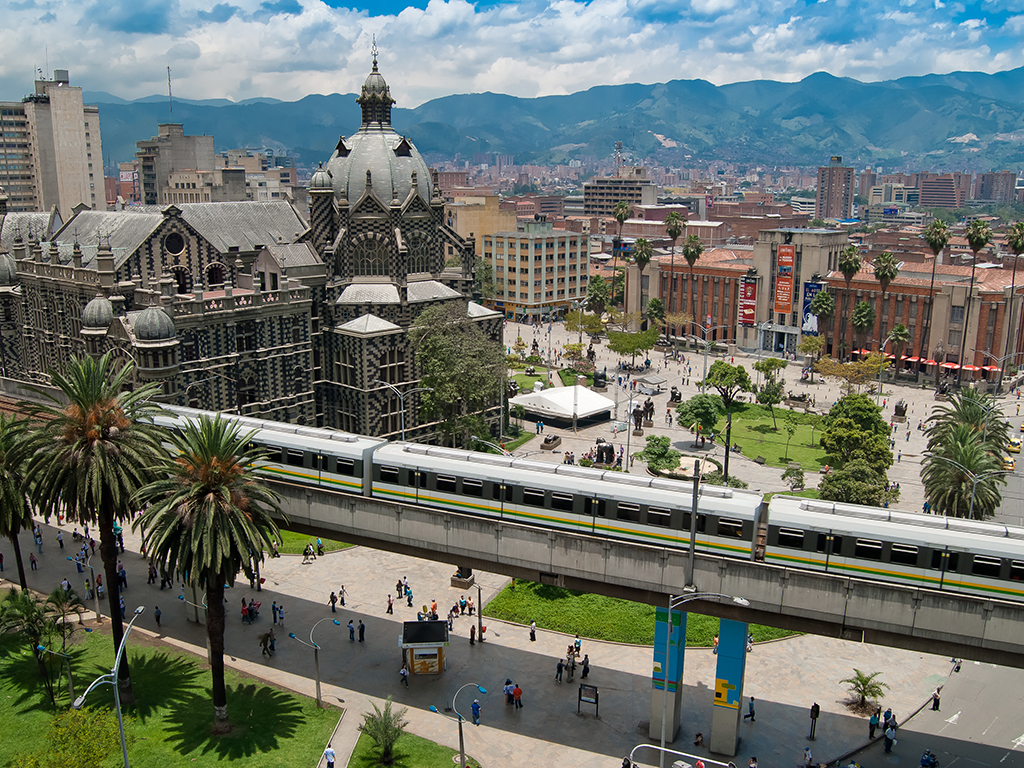Medellin is a city where life bursts from every corner. Here, progress and innovation can be seen everywhere. An open-door policy is the city’s strongest trait and visitors are welcomed warmly.
The city is taking an exciting urban path towards a democratic and participatory social model; in Medellin, evidence of urban and social metamorphosis is visible all over. See it in the architecture, Library Parks, schools, plazas, sports venues, and all of the other new cultural spaces for citizens.
Alongside this urban transformation, the city is undergoing a profound social change. This is the result of the collective effort of the local government, the private sector, academia, citizen groups, NGOs, workers, and citizens in general. Their warmth, hospitality, and hardworking spirit sum up the paisas.
Medellin has realised its potential for business tourism, culture, nature and health, and the value that the proper management of these activities could add to the city’s economy. Recognising the city’s impressive potential, Business Destinations has named Medellin Convention and Visitors Bureau the Best Destination for MICE, South America, 2013.
Nature and culture
Medellin is a capital of fashion, and Latin America’s industrial centre of textiles and apparel. The Arvi Park contains a range of natural attractions: Nutibara Hill and El Volador Hill, the Explora Park and Aquarium, and the Botanical Garden with its Orquideorama (Orchid Dome). The Orquideorama is particularly beautiful, a cradle of multicoloured flowers and delicious tropical fruits.
Plaza Botero holds 23 sculptures from celebrated maestro Fernando Botero, and the most comprehensive collection of his work – 117 items in total – is exhibited at the Museum of Antioquia. This, along with its museums and entertainment spaces, makes Medellin an important cultural hub.
Getting around
All of the areas of Medellin are connected by the Integrated Transport System of the Aburrá Valley (SITVA), the Metro, Metroplus and Metrocable. They make the whole city accessible, while helping the environment and, in the case of the Metrocable, have even become a tourist attraction.
The Orquideorama is a cradle of multicoloured flowers and delicious tropical fruits
The Mayor’s office of Medellin, through its development plan ‘A Home for Life’, aims to make Medellin a sustainable and growing territory. It’s on the path to becoming equitable and inclusive, ready to experience proper internationalisation. The work of the Mayor’s office and promotions conducted by Medellin’s Convention and Visitors Bureau has bolstered Medellin’s profile as an important destination for business tourism. The city currently ranks 21st in the world, according to the ICCA in 2012.
Future goals are high; the Mayor’s office has been making progress to formulate strategies, programmes and projects, instigating development by generating jobs, a better quality of life, and welfare for all households.
Medellin has already played host to a number of important events, including: the 38th General Assembly of the Organisation of American States, 2008; The Board of Governors’ Assembly of the Inter-American Development Bank, 2009; the South American Games, 2010; the Latin-American Congress on Culture, 2010; the Biennial of Architecture and Urbanism, 2010; and the eighth Inter-American Water Dialogue D7, 2011.
Infrastructure for events
The city has its own event centre, the Plaza Mayor Convention and Exhibition centre. It boasts 385,000sq m of space, encompassing 22 meeting rooms and five main pavilions, with a capacity of up to 35,000 people. Medellin also has other event spaces, such as the Orquideorama in the Botanical Garden, and many other halls distributed across the city’s hotels, museums, science and technology centres, the planetarium, Library Parks, banquet houses, and much more. Medellin also has a variety of hotels, suiting parties with any size or budget and totalling approximately 5,617 rooms and 9,113 beds.
Medellin is connected to major cities in Latin America, making it easily accessible wherever you are. The José María Córdova (JMC) International Airport has 97 weekly flights, including direct international flights to Panama, Miami, Quito, Caracas, Fort Lauderdale, San José in Costa Rica, Lima, Madrid, Curaçao, and New York. In addition, the JMC has an average of 34 daily flights to and from Bogotá, the capital of Colombia.
Innovation is the key factor that has characterised the city of Medellin and its inhabitants. This culture of strength and the creativity to pursue innovative business ventures has gained the city international recognition, earning it the Most Innovative City award in 2013, granted by the Urban Land Institute and the Wall Street Journal. It will also host the seventh World Urban Forum, between April 5-11, 2014.
The city’s vision
By 2015, Medellin hopes to be among Latin America’s top five host cities for international events. The Mayor’s office of Medellin, with the help of the Convention and Visitors Bureau, the Agency for Cooperation and Investment and its various offshoots, aim to create a higher rate of tourism growth in Medellin than in any other Colombian city. To achieve this, the city has developed a strategic plan that comprises: attracting 105 new events; reporting at least 40 events to ICCA; hosting at least 120 events a year in the city at the national and international levels.
Medellin wants to be seen as a city that creates and builds, with an eye on the future, using innovative and inclusive ideas. The city is moving forward with a positive attitude – an attitude that characterises the Medellinenses people – a strong, creative, enterprising, and visionary attitude.





